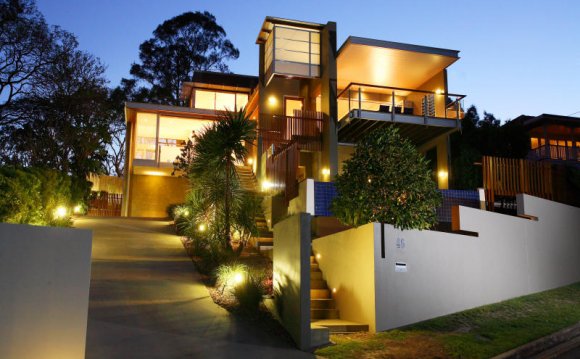

Landscape Lighting Inspiration Gallery
With a project like landscape lighting, it's sometimes hard to know what to do or where to start. The slideshow below helps you to better understand your options and visualize the impact outdoor lighting can have on your home.
See Your Landscape in a New Light
1. Observe your landscape. Which two areas or architectural features deserve highlighting? Do pockets of darkness need to be addressed?
2. Select the right fixtures and lamp wattage to create the desired lighting effect.
3. Locate your outlet and make sure it’s a GFCI (ground fault circuit interrupter) power outlet. These outlets typically have a reset button. If there is no button, use a GFCI tester to determine the outlet type.
4. Add the wattage of each light fixture in your lighting plan to determine your total fixture wattage.
5. Select your transformer. A transformer should be 20 watts larger than your total fixture wattage. If you plan to buy additional lighting later, purchasing a larger transformer now could save money.
6. Measure the distance from the power supply to the farthest fixture, plus 1-2 feet of additional cable for each fixture, to determine how much cable and gauge is needed for the project. If your total fixture wattage is greater than 200, choose a 12-gauge cable. If your total fixture wattage is less than 200, choose a 16-gauge cable.
7. Follow the manufacturer’s installation instructions and look for installation tips on the lighting packaging.
Landscape lighting makes a tremendous difference in your home's curb appeal.
Solar Landscape Lighting
Solar lighting has quickly become a popular and cost-effective way to light your outdoors. With no wiring or electricity, these lights can be installed anywhere. They work by using a solar collection panel that absorbs energy from sunlight and converts it into electrical power that's stored in highly efficient rechargeable batteries. As the sun sets, the solar lights turn on. In ideal situations, fully charged solar lights remain on for up to 15 hours.
LED solar lights provide bright, white light. However, all solar-powered lighting requires a sufficient amount of sunlight to recharge the batteries. Solar lighting performance is based on the amount of sunlight received during the day.
Other benefits of solar lighting include:
- No tools needed for assembly
- Easy bulb replacement and easy-to-handle connector
- Works during power outages
- Eco-friendly
- Little maintenance needed
- Can reduce utility expenses
YOU MIGHT ALSO LIKE












